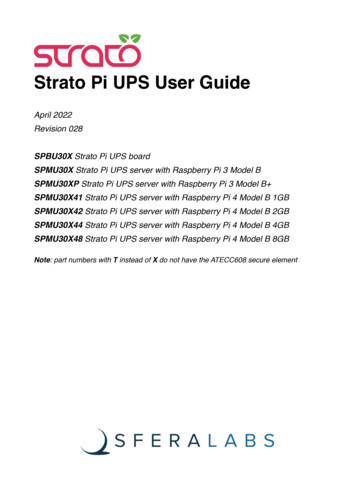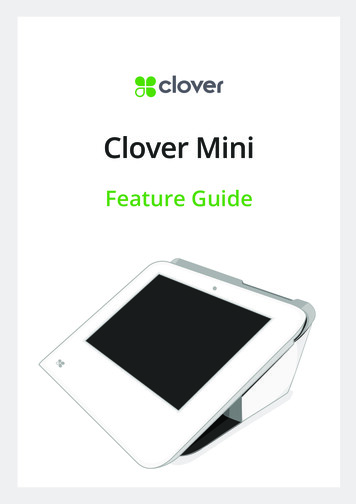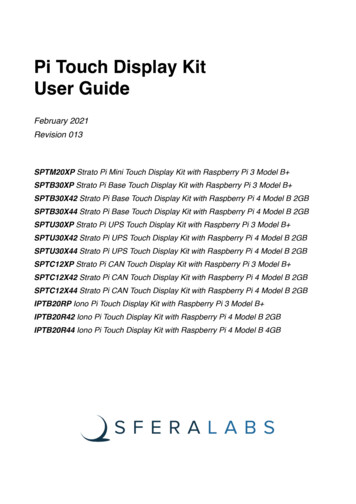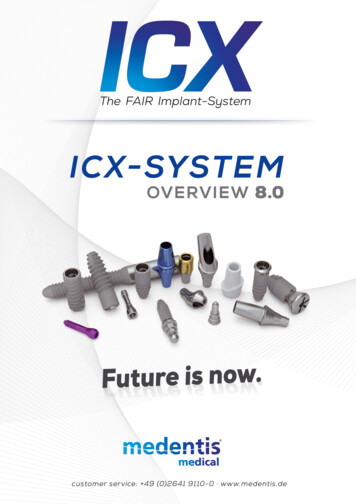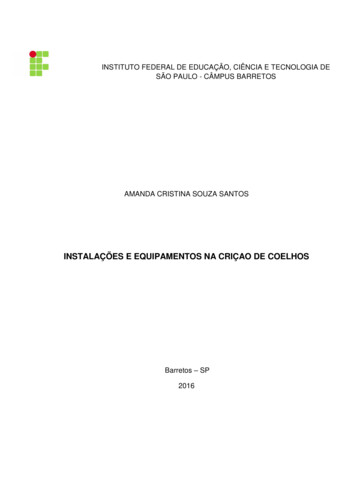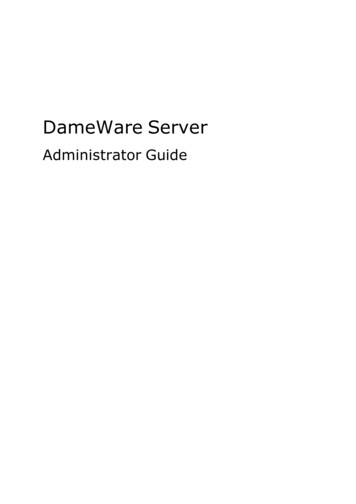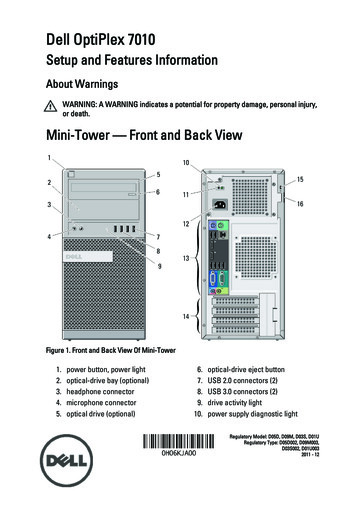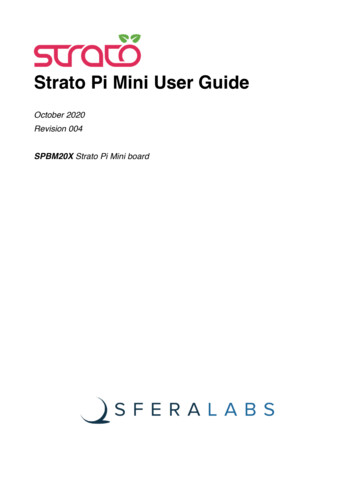
Transcription
Strato Pi Mini User GuideOctober 2020Revision 004SPBM20X Strato Pi Mini board
Safety informationQualified personnel3Hazard levels3Safety instructions4General safety instructions4Battery4Introduction6Features6Usage and connections7Hardware Installation7Replacing the RTC backup battery7Terminal block9Device identification9Power supply10Dedicated GPIO pins11Software installation and configuration12Strato Pi Mini utility12Real Time Clock software12Testing the Real Time Clock13Using Strato Pi Mini14Real Time Clock14ATECC608A Secure Element14Buzzer14Block diagram16Technical specifications17Dimensions18Disposal19Installation and use restrictions19Standards and regulations19Safety instructions19Set-up19Conformity Information1320EU20USA20CANADA21RCM AUSTRALIA / NEW ZEALAND21Strato Pi Mini User Guide
Be sure to always remove the power supply before connecting ordisconnecting the Strato Pi Mini board to Raspberry Pi.Follow all applicable electrical safety standards, guidelines,specifications and regulations for installation, wiring and operations ofStrato Pi Mini.Carefully and fully read this Strato Pi Mini user guide before installation.Strato Pi Mini is not authorised for use in safety-critical applications where a failure of theproduct would reasonably be expected to cause personal injury or death. Safety-criticalapplications include, without limitation, life support devices and systems, equipment orsystems for the operation of nuclear facilities and weapons systems. Strato Pi Mini isneither designed nor intended for use in critical military or aerospace applications orenvironments and for automotive applications or environment. Customer acknowledgesand agrees that any such use of Strato Pi Mini is solely at Customer's risk, and thatCustomer is solely responsible for compliance with all legal and regulatory requirements inconnection with such use.Sfera Labs S.r.l. may make changes to specifications and product descriptions at any time,without notice. The product information on the web site or materials is subject to changewithout notice.Please download and read the Sfera Labs Terms and Conditions document available at:http://www.sferalabs.ccStrato and Sfera Labs are trademarks of Sfera Labs S.r.l. Other brands and names may beclaimed as the property of others.Copyright 2016-2019 Sfera Labs S.r.l. All rights reserved.2Strato Pi Mini User Guide
Safety informationCarefully and fully read this user guide before installation and retain it for future reference.Qualified personnelThe product described in this manual must be operated only by personnel qualified for thespecific task and installation environment, in accordance with all relevant documentationand safety instructions. A qualified person should be capable of fully identifying allinstallation and operation risks and avoid potential hazards when working with this product.Hazard levelsThis manual contains information you must observe to ensure your personal safety andprevent damage to property. Safety information in this manual are highlighted by the safetysymbols below, graded according to the degree of danger.DANGERIndicates a hazardous situation which, if not avoided, will result in death or seriouspersonal injury.WARNINGIndicates a hazardous situation which, if not avoided, may result in death or seriouspersonal injury.CAUTIONIndicates a hazardous situation which, if not avoided, can result in minor or moderatepersonal injury.NOTICEIndicates a situation which, if not avoided, can result in damage of property.3Strato Pi Mini User Guide
Safety instructionsGeneral safety instructionsProtect the unit against moisture, dirt and any kind of damage during transport, storageand operation. Do not operate the unit outside the specified technical data.Never open the housing. If not otherwise specified, install in closed housing (e.g.distribution cabinet). Earth the unit at the terminals provided, if existing, for this purpose.Do not obstruct cooling of the unit. Keep out of the reach of children.WARNINGLife threatening voltages are present within and around an open control cabinet.When installing this product in a control cabinet or any other areas where dangerousvoltages are present, always switch off the power supply to the cabinet or equipment.WARNINGRisk of fire if not installed and operated properly.Follow all applicable electrical safety standards, guidelines, specifications and regulationsfor installation, wiring and operations of this product.The Raspberry Pi board could generate a substantial amount of heat when the softwareforces the CPU and/or GPU to operate at high load levels. Ensure that the product isproperly installed and ventilated to prevent overheat.NOTICEThe connection of expansion devices to this product may damage the product and otherconnected systems, and may violate safety rules and regulations regarding radiointerference and electromagnetic compatibility.Use only appropriate tools when installing this product. Using excessive force with toolsmay damage the product, alter its characteristics or degrade its safety.BatteryThis product uses a small lithium non-rechargeable coin battery to power its internal realtime clock (RTC).4Strato Pi Mini User Guide
WARNINGImproper handling of lithium batteries can result in an explosion of the batteries and/orrelease of harmful substances.Worn-out or defective batteries can compromise the function of this product.Replace the RTC lithium battery before it is completely discharged. The lithium batterymust be replaced only with an identical battery. See the "Replacing the RTC backupbattery" section for instructions.Do not throw lithium batteries into fire, do not solder on the cell body, do not recharge, donot open, do not short-circuit, do not reverse polarity, do not heat above 100 C and protectfrom direct sunlight, moisture and condensation.Dispose of used batteries according to local regulations and the battery manufacturer'sinstructions.5Strato Pi Mini User Guide
IntroductionStrato Pi Mini is an expansion board that enhances the Raspberry Pi 2 Model B andRaspberry Pi 3 Model B or B with a rugged power supply, a real time clock with on-boardlithium back-up battery, a buzzer and the Microchip ATECC608A secure element chip.Features 9-28Vdc power supply, with surge and reverse polarity protection, and 1.1A resettablefuse real time clock with replaceable CR1025 Lithium / Manganese Dioxide back-up battery embedded Microchip ATECC608A secure element chip on-board buzzer, connected to an I/O pin of the Raspberry Pi board, for acousticfeedback on-board power-on LED high-current stabilised 5Vdc output terminal block power supply on screw terminal block.6Strato Pi Mini User Guide
Usage and connectionsSTRATO PI MINI BOARD INSTALLED ON THE RASPBERRY PIHardware InstallationThe Strato Pi Mini board is supplied with all connectors pre-installed. No soldering isrequired. You should connect Strato Pi to Raspberry Pi aligning the GPIO connector. Useappropriate turrets/spacers to firmly bolt the two boards together, ensuring that noconductive part of one board touches any part of the other board.The Strato Pi Mini board 12-way pass-through connector must be aligned with the left sideof the Pi’s GPIO connector (pins 1-12).NOTICEThe GPIO connector of the Strato Pi Mini board must be perfectly aligned to the RaspberryPi's GPIO pins. Turning on the Raspberry Pi and/or the Strato Pi Mini board with the GPIOnot correctly connected will damage both the Raspberry Pi and Strato Pi Mini board.Replacing the RTC backup batteryStrato Pi Mini has a hardware real time clock with a dedicated long-life non-rechargeableback-up battery.Strato Pi Mini is shipped with a CR1025 Lithium / Manganese Dioxide (Li/MnO2) batteryinstalled.7Strato Pi Mini User Guide
The battery is only used to power the RTC chip when the main power is not available(when the Raspberry Pi is off). Depending on operating conditions it should last up to twoyears if the Strato Pi board is not powered, more if the Strato Pi Mini receives externalpower.WARNINGImproper handling of lithium batteries can result in an explosion of the batteries and/orrelease of harmful substances.Worn-out or defective batteries can compromise the function of this product.KEEP OUT OF REACH OF CHILDREN. Swallowing may lead to serious injury or death inas little as 2 hours due to chemical burns and potential perforation of the esophagus.Immediately see doctor.Replace the RTC lithium battery before it is completely discharged. Replace the batteryevery 5 years even if the battery is still working properly. The lithium battery must bereplaced only with an identical CR1025 Lithium / Manganese Dioxide (Li/MnO2) battery.Do not throw lithium batteries into fire, do not solder on the cell body, do not recharge, donot open, do not short-circuit, do not reverse polarity, do not heat above 100 C and protectfrom direct sunlight, moisture and condensation.Dispose of used batteries according to local regulations and the battery manufacturer'sinstructions.The RTC backup battery holder is soldered to the top layer of the circuit board, next to theGPIO connector.NOTICEBefore accessing the Strato Pi Mini board, disconnect all power sources and anyconnection to external devices, including USB cables.Use a non-conductive pin or small tool to help extract the battery from its holder. Insert thenew battery with a gentle push. You don't need tools to insert the battery. The battery isheld into place by a spring contact.Be sure to insert the battery so that the positive ( ) terminal of the battery is in contact withthe outer body of the battery holder, and the negative (-) terminal is in contact with thecontact pad of the circuit board.Reversing the battery polarity may damage the product.The real time clock will reset its time immediately when the RTC backup battery isdisconnected.8Strato Pi Mini User Guide
Terminal blockA 2-way terminal block is used for the input voltage connection.An additional 2-way terminal block is used to make the internal 5V high current outputsupplied to the Raspberry Pi available for other external loads.The maximum conductor cross section is 2.08 mm2 (14 AWG). Recommended strippinglength is 6 mm. Screw thread is M3. Never exceed 0.5 Nm torque when tightening thescrews.THE STRATO PI MINI CIRCUIT BOARDDevice identificationThe device can be identified with the information provided in the rating and identificationplate, placed on the device packaging.EXAMPLE RATING AND IDENTIFICATION PLATE9Strato Pi Mini User Guide
Power supplyStrato Pi Mini be powered with DC voltage only: DC: nominal voltage range 9.0V to 28.0V.Respect the correct polarity shown in the schematic diagram ( -). The power supplycircuit implements reverse polarity protection using an auto resetting fuse and surgeprotection up to 500V/2ohms 1.2/50μs.A blue on-board LED is lit when power supply is available.When a Strato Pi Mini board is used, never connect the Raspberry Pi micro-USB powerplug.The Strato Pi Mini power supply stage is optimised to deliver up to 2.0A continuous 5Voutput to the Raspberry Pi. Because Strato Pi Mini has an 1.1A resettable fuses (polyfuse)on the power supply line, the maximum current that its regulator can deliver is also limitedby this fuse, and depends on the input voltage. The following table lists the typicalmeasured output current of the power supply stage at different input voltages, and thecorresponding input current. At high input voltage levels, the voltage regulator’s thermalprotection becomes the limiting factor.The voltage regulator can supply up to 3.0A 5V output short duration current peaks( 1sec).STRATO PI MINI POWER SUPPLY STAGE TYPICAL IN/OUT VOLTAGE AND CURRENT10Strato Pi Mini User Guide
Dedicated GPIO pinsStrato Pi Mini uses some of the Raspberry Pi’s GPIO pins.GPIO pinDirectionDescriptionGPIO2/SDAI2C SDA line for the real time clock and ATECC608 secure chipGPIO3/SCLI2C SCL line for the real time clock and ATECC608 secure chipGPIO17outset to high to sound the buzzerThe GPIO17 pin should not be used for other functions.11Strato Pi Mini User Guide
Software installation and configurationAll features of Strato Pi Mini, except the real time clock and the ATECC608 secureelement, are controlled via dedicated GPIO pins and can be used with any operatingsystem and programming language that supports the GPIO pins control on Raspberry Pi.The real time clock and the ATECC608 are interfaced via the I2C serial bus.The following software installation notes are based on the Raspbian Stretch operatingsystem.Strato Pi Mini utilityThe Strato Pi utility is a simple command-line script to control Strato Pi’s buzzer.Run the following commands to download and install the Strato Pi utility: cd /usr/local/bin sudo wget http://sferalabs.cc/files/stratopimini/strato sudo chmod 755 stratoYou can run the Strato Pi utility without arguments to print its options: stratoUsage: strato beep on off length millis length millis pause millis repeatsAll commands should be run as superuser, so always use sudo to run strato.Real Time Clock softwareThe RTC is based on the Microchip MCP79410 module and is connected to the RaspberryPi via its I2C serial bus.Before downloading the installation utility, you should enable I2C and install the “i2c-tools”package.To enable I2C, run the “raspi-config” configuration utility: sudo raspi-configThen go to “Advanced Options”, “I2C” and select “yes” to enable the I2C interface, thenreboot your Raspberry Pi.To install the “i2c-tools” package: sudo apt-get update sudo apt-get install i2c-toolsWith these prerequisite installs completed, you should download and run Strato Pi’sinstallation script: cdwget http://sferalabs.cc/files/strato/rtc-installchmod 755 rtc-installsudo ./rtc-installIf the script completes with no errors, delete the installation script and reboot: rm rtc-install12Strato Pi Mini User Guide
sudo rebootTesting the Real Time ClockAssuming you are connected to the Internet and your Pi was able to reach a public NTP(Network Time Protocol) server, you should see the current date and time using the “date”command: dateThu Dec 10 18:02:32 CET 2015Also check the date and time stored in the hardware clock: sudo hwclock -rThu 10 Dec 2015 06:03:01 PM CET-0.546570 secondsIf the returned date and time is not correct, or “hwclock” returns an error, use the “-w”option to set the hardware clock to the current time: sudo hwclock -wThen recheck the time stored in the hardware clock to ensure it matches. Linux may havefailed to automatically update the hardware clock after the last reboot if its internalregisters contained invalid values.If the RTC still doesn’t work, you should check if the Pi sees the RTC chip on the I2C bus.Run these two commands: sudo modprobe -r rtc ds1307 sudo i2cdetect 1WARNING! This program can confuse your I2CI will probe file /dev/i2c-1.I will probe address range 0x03-0x77.Continue? [Y/n]0 1 2 3 4 5 6 7 8 9 a b c00:-- -- -- -- -- -- -- -- -- -10: -- -- -- -- -- -- -- -- -- -- -- -- -20: -- -- -- -- -- -- -- -- -- -- -- -- -30: -- -- -- -- -- -- -- -- -- -- -- -- -40: -- -- -- -- -- -- -- -- -- -- -- -- -50: -- -- -- -- -- -- -- 57 -- -- -- -- -60: 60 -- -- -- -- -- -- -- -- -- -- -- -70: -- -- -- -- -- -- -- —bus, cause data loss and worse!d--------e--------f------6fYou should see “6f” in the address list. This is the address of the RTC.If the RTC address is detected, double check your software installation for issues at theLinux modules level.Run the “lsmod” command to list the loaded modules and check that “i2c dev” and“i2c bcm2708” are both listed.If the RTC address is not detected, the cause could be a hardware problem, on the Stratoboard or the Raspberry Pi. If you have another Pi or Strato board, try swapping them toisolate the faulty board.13Strato Pi Mini User Guide
Using Strato Pi MiniReal Time ClockStrato Pi Mini has a hardware real time clock with a dedicated long-life non-rechargeableback-up battery.Once the RTC modules and configuration files are properly installed, you will simply usethe date and time commands to control the hardware clock.ATECC608A Secure ElementStrato Pi Mini embeds the ATECC608A secure element chip from Microchip. TheATECC608A is connected to the Raspberry Pi via the I2C bus (default address: 0x60).Its key features are: Cryptographic co-processor with secure hardware-based key storage Protected storage for up to 16 Keys, certificates or data Hardware support for asymmetric sign, verify, key agreement – ECDSA: FIPS186-3Elliptic Curve Digital Signature ECDH: FIPS SP800-56A Elliptic Curve Diffie-Hellman NIST standard P256 elliptic curve support Hardware support for symmetric algorithms SHA-256 & HMAC hash including off-chip context save/restore AES-128: encrypt/decrypt, galois field multiply for GCM Networking key management support Turnkey PRF/HKDF calculation for TLS 1.2 & 1.3 Ephemeral key generation and key agreement in SRAM – Small messageencryption with keys entirely protected Secure boot support Full ECDSA code signature validation, optional stored digest/signature –optional communication key disablement prior to secure boot Encryption/Authentication for messages to prevent on-board attacks Internal high-quality FIPS 800-90 A/B/C Random Number Generator (RNG) Two high-endurance monotonic counters Guaranteed unique 72-bit serial number.BuzzerStrato Pi Mini has an on-board buzzer that can be controlled using GPIO17. Simply setGPIO17 to high to emit a continuous sound, and back to low to stop. The buzzer is notintended to emit sound indefinitely and could be damaged doing so.The Strato Pi utility has several commands to control the buzzer.14Strato Pi Mini User Guide
Buzzer on continuously: sudo strato beep onBuzzer off: sudo strato beep offBuzzer on for 500 milliseconds: sudo strato beep 500Buzzer on for 500 milliseconds, followed by 100 milliseconds pause, repeated three times: sudo strato beep 500 100 315Strato Pi Mini User Guide
Block diagramSTRATO PI MINI BLOCK DIAGRAM16Strato Pi Mini User Guide
Technical specificationsPower supply9/28V (VDC)Reverse polarity protection with auto resetting fuse.Surge protection up to 500V/2ohms 1.2/50μs5Vcc maximum output current (Ta 22 C)1.5 A @ 9V PS2.0 A @ 12V PS2.0 A @ 24V PSRaspberry platform compatibilityPi 3 Model B Pi 3 Model BPi 2 Model BPi 1 Model B Real time clockInternal RTCC circuit with backup lithium battery.Only use CR1025 Lithium / Manganese Dioxide (Li/MnO2) batteries.Expected battery life without main power supply: 2 yearsDimensions (W x D)40 x 56 mmOperating temperature0 50 CStorage temperature-20 70 CRelative humidity5% to 90% noncondensingWeight16 g (Strato Pi Mini board only)17Strato Pi Mini User Guide
DimensionsDIMENSIONS (mm)18Strato Pi Mini User Guide
DisposalWaste Electrical & Electronic Equipment(Applicable in the European Union and other European countries withseparate collection systems). This marking on the product, accessories orliterature indicates that the product should not be disposed of with otherhousehold waste at the end of their working life. To prevent possible harm tothe environment or human health from uncontrolled waste disposal, separatethese items from other types of waste and recycle them responsibly topromote the sustainable reuse of material resources. Household usersshould contact either the retailer where they purchased this product, or their localgovernment office, for details of where and how they can take these items forenvironmentally safe recycling. This product and its electronic accessories should not bemixed with other commercial wastes for disposal.Strato Pi Mini contains a small non rechargeable manganese dioxide lithium coin battery.Always remove the battery before disposing of this product.Installation and use restrictionsStandards and regulationsThe design and the setting up of electrical systems must be performed according to therelevant standards, guidelines, specifications and regulations of the relevant country. Theinstallation, configuration and programming of the devices must be carried out by trainedpersonnel.The installation and wiring of connected devices must be performed according to therecommendations of the manufacturers (reported on the specific data sheet of the product)and according to the applicable standards.All the relevant safety regulations, e.g. accident prevention regulations, law on technicalwork equipment, must also be observed.Safety instructionsCarefully read the safety information section at the beginning of this document.Set-upFor the first installation of the device proceed according to the following procedure: make sure all power supplies are disconnected install and wire the device according to the schematic diagrams on the specific productuser guide after completing the previous steps, switch on the power supply and other relatedcircuits.19Strato Pi Mini User Guide
Conformity InformationThe declaration of conformity is available on the internet at the following address: https://www.sferalabs.cc/strato-pi/EUThis device complies with the essential requirements of the following directives andharmonised standards: 2014/30/UE (EMC) EN61000-6-2:2019 (EMC Immunity for industrial environments) EN61000-6-3:2007/A1:2011/AC:2012 (Emission for residential, commercial and lightindustrial environments) 2011/65/UE (RoHS).USAFCC Radio Frequency Interference Statement:This equipment has been tested and found to comply with the limits for a Class B digitaldevice, pursuant to part 15 of the FCC Rules. These limits are designed to providereasonable protection against harmful interference in a residential installation. Thisequipment generates, uses and can radiate radio frequency energy and, if not installedand used in accordance with the instructions, may cause harmful interference to radiocommunications. However, there is no guarantee that interference will not occur in aparticular installation. If this equipment does cause harmful interference to radio ortelevision reception, which can be determined by turning the equipment off and on, theuser is encouraged to try to correct the interference by one or more of the followingmeasures: Reorient or relocate the receiving antenna Increase the separation between the equipment and receiver Connect the equipment into an outlet on a circuit different from that to which thereceiver is connected Consult the dealer or an experienced radio/TV technician for help.Shielded Cables:Shielded cables must be used with this equipment to maintain compliance with FCCregulations.Modifications:Changes or modifications not expressly approved by the party responsible for compliancecould void the user's authority to operate the equipment.20Strato Pi Mini User Guide
Conditions of Operations:This device complies with Part 15 of the FCC Rules. Operation is subject to the followingtwo conditions: (1) this device may not cause harmful interference, and (2) this devicemust accept any interference received, including interference that may cause undesiredoperation.CANADAThis Class B digital apparatus complies with Canadian ICES-003(B).Cet appareil numérique de la classe B est conforme à la norme NMB-003(B) du Canada.RCM AUSTRALIA / NEW ZEALANDThis product meets the requirements of the standard EN 61000-6-3:2007/A1:2011/AC:2012 - Emission for residential, commercial and light-industrial environments.21Strato Pi Mini User Guide
3 Strato Pi Mini User Guide. Safety instructions General safety instructions Protect the unit against moisture, dirt and any kind of damage during transport, storage . Strato Pi Mini is an expansion board that enhances the Raspberry Pi 2 Model B and Raspberry Pi 3 Model B or B wi
